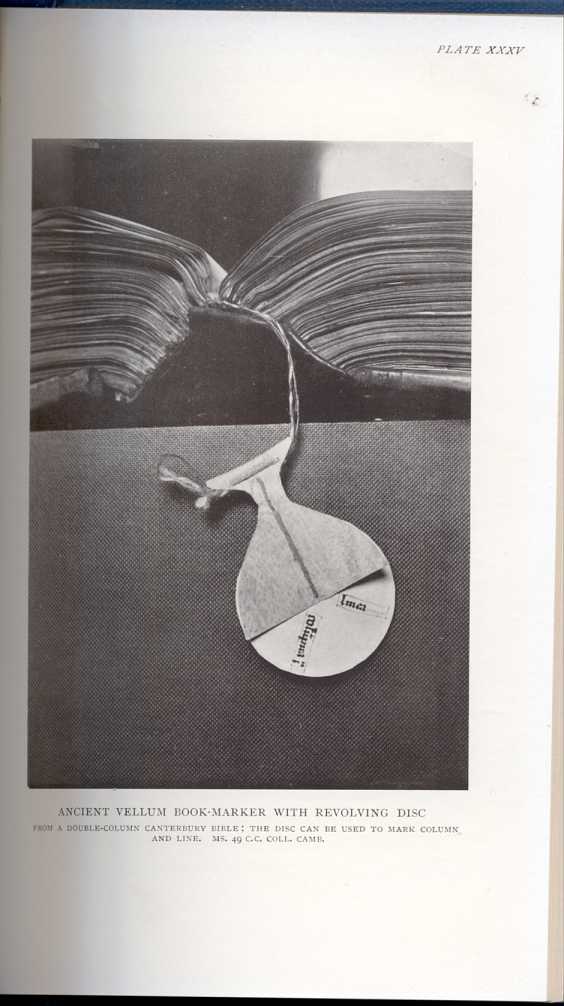| CHAPTER XI: THE CHARACTER OF THE MEDIEVAL LIBRARY, AND THE EXTENT
OF CIRCULATION OF BOOKS Old English libraries; the making, collection and use of books during the middle ages | ||
4. § IV
In the fourteenth and fifteenth centuries romances began to creep into all libraries, save the academic, in
The romances oftenest appearing in monastic catalogues and other records are the following: The Story of Troy, especially Joseph of Exeter's Latin version, the great Arthurian cycle, the beautiful story of Amis and Amiloun, renowned all over Europe, Joseph of Arimathea, Charlemagne, Alexander, which was of the best of romances, Guy of Warwick, which was very popular, and the semi-historical Richard Cœur de Lion. But many others were in circulation. In Cursor mundi a number of the popular stories of the day are mentioned—
And romans rede in divers maneree,
Of Alexandre the conquerour,
Of Julius Cæsar[11.43] the emperour,
Of Greece and Troy the strong stryf,
Ther many a man lost his lyfe:
Of Brut,[11.44] that baron bold of hond,
The first conquerour of Englond,
Of King Arthur that was so ryche;
Was non in hys tyme so ilyche [alike, equal]:
Of wonders that among his knyghts felle,
And auntyrs [adventures] dedyn as men her telle
As Gaweyn, and othir full abylle,
Which that kept the round tabyll,
How King Charles and Rowland fawght,
With Sarazins, nold thei be cawght;
Of Tristram and Ysoude the swete,
How thei with love first gall mete,
Of Kyng John, and of Isenbras,
Of Ydoine and Amadas."[11.45]
Of Kyng Rychard, and Owayne,
Of Tristram and Percyvayle,
Of Rowland Ris,[11.47] and Aglavaule,
Of Archeroun, and of Octavian,
Of Charles, and of Cassibelan.
Of Keveloke,[11.48] Horne, and of Wade
In romances that ben of hem bimade,
That gestours dos of hem gestes,
At maungeres, and at great festes,
Her dedis ben in remembrance,
In many fair romance."
Popular romances of this kind had a great influence upon the lives of the people. The long lists of medieval theology and sophistry usually laid before us, and the great majority of the writings which have survived, sometimes lead us to believe the culture of the Middle Ages to have been of a more serious cast than it really was. The oral circulation of romance literature must have been enormous. The spun-out, dreary poems which now make such difficult reading are infinitely more entertaining when read aloud: the voice gives life and character to a humdrum narrative, and the gestour would know how to make the best of incidents which he knew from experience to be specially interesting to an audience. Such yarns would be most attractive to "lewd" or illiterate men—
On Englyssh tunge to make thys boke:
For many ben of swyche manere
That talys and rymys wyl blethly[11.49] here,
Ye gamys and festys, and at the ale." [11.50]
 [Description: ANCIENT VELLUM BOOK-MARKER WITH
REVOLVING DISC FROM A DOUBLE-COLUMN CANTERBURY BIBLE; THE DISC CAN BE
USED TO MARK COLUMN AND LlNE. MS. 49 C.C. COLL. CAMB.]
[Description: ANCIENT VELLUM BOOK-MARKER WITH
REVOLVING DISC FROM A DOUBLE-COLUMN CANTERBURY BIBLE; THE DISC CAN BE
USED TO MARK COLUMN AND LlNE. MS. 49 C.C. COLL. CAMB.]The need of multiplying manuscripts of these poems would not be greatly felt. The reciter would be obliged to learn them off by heart; he need not, and often did not, possess written versions of the poems he recited. And even literate men, as Bishop Grosseteste, preferred to listen to these gestours, rather than to read the narrative themselves. Therefore, any estimate we may form of the number of manuscripts of romances in existence at any time in the fourteenth century, for example, would give not the smallest idea of the extent to which these tales were known.
| CHAPTER XI: THE CHARACTER OF THE MEDIEVAL LIBRARY, AND THE EXTENT
OF CIRCULATION OF BOOKS Old English libraries; the making, collection and use of books during the middle ages | ||